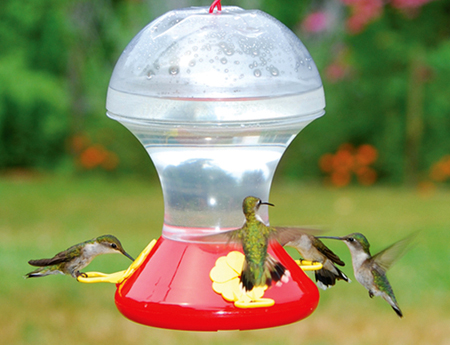
A tiny bird that weighs a grand total of 3 grams can make an afternoon sitting in a backyard or garden a rare pleasure that combines both relaxing and exciting aspects for those who watch closely.
Hummingbirds, which the early Spanish explorers brought to the United States and called “joyas volardores,” or flying jewels, have the fastest wing beats of any bird. In fact, a hummingbird’s flight speed can average 25 to 30 miles per hour, and they can dive up to 60 miles per hour. Additionally, hummingbirds can rotate each of their wings in a circle, allowing them to be the only bird that can fly forward, backward, up, down, sideways and even hover in space.
To hover, hummingbirds move their wings forward and backward in a repeated figure eight. The can even fly short distances upside down, a trick rollover the feisty flyers employ when being attacked by another bird.
Attracting these fascinating feathered creatures to your backyard is easy once you understand them, according Jeff Watson of Songbird Essentials, a national manufacturer that supplies bird products to a variety of East End retailers, including Wild Bird Crossing in Bridgehampton.
Mr. Watson explained that even though the highly energetic birds are known for their fast maneuvers, they also emit a very soothing and calming “swooping” noise as they fly because their wings flap so rapidly.
The tiny winged creatures are even more of a study in contradiction. Although they are the smallest birds in New York, they are highly territorial and prone to getting into territorial tiffs with much larger avian species over flowers and hummingbird feeders, Mr. Watson said.
Though they feed on spiders and gnats to satisfy their protein needs, hummingbirds may visit up to 1,000 flowers a day in their non-stop quest for fuel. Thus, flowers and feeders attract the unique birds to a garden or backyard, according to Mr. Watson.
Hummingbirds are drawn to red, yellow and purple flowers as well as to feeders that offer sugary nectars, Mr. Watson explained. They will also flock to specific flowers such as honeysuckle, morning glory, eucalyptus, butterfly bush, gooseberry, hibiscus and azaleas, he said.
Michael Mackey, the manager of Wild Bird Crossing in Bridgehampton, noted that columbines, trumpet vine and fuchsia also act as hummingbird magnets.
The hummingbird feeder serves as another way to bring the tiny birds to a backyard, Mr. Mackey said. He explained that the feeders usually are red, as that bright color replicates what the birds are attracted to in nature. Some feeders even feature big artificial flowers, which also mimic nature, and draw the birds.
Feeders typically hang from trees, while some are freestanding, hanging from a pole in the middle of a yard. Some feeders add to the aesthetics of a garden, going beyond the simple functional purpose of attracting hummingbirds to becoming lawn art, according to several hummingbird-related websites.
But more important than how the feeder looks, the nectar in it must be fresh in order to have the birds humming around a backyard or garden, Mr. Mackey said.
“At least once a week, you have to clean the feeder and change the nectar,” he said. “If it’s hot, you have to do it twice a week.”
Mr. Mackey explained that the more diligent gardeners are with the feeders, the more hummingbirds they will attract. The fresher the nectar the better.
“A lot of times hummingbirds come to the feeder every day,” he said.
Mr. Watson said that a simple way to make hummingbird nectar is to add one part sugar to four parts water. And though many hummingbird aficionados believe that the nectar must be red, Mr. Mackey reported that belief is a misconception.
The only hummingbird that lives in the northeast is the ruby-throated hummingbird. Like most every species of bird, male and female hummingbirds vary slightly in their appearance. Adult male birds have an emerald green back, an iridescent ruby red-colored throat that may appear black under some lighting conditions, gray flanks and a forked tail with no white. The female has an emerald green back, white breast and throat and a rounded tail with white tips. The female, which is larger than the male, also has a longer bill.
Juveniles of both sexes look like the adult female, only smaller.
West of the Rocky Mountains, there are upwards of 50 different kinds of hummingbirds. But the ruby-throated hummingbird that makes its home here is very special in that it travels huge distances to summer here on the East End, according to Mr. Mackey.
“They migrate to Central and South America in the fall,” Mr. Mackey said.
In addition, Mr. Mackey said that if the birds regularly frequent a certain feeder in the spring and summer, they’ll return to it in the spring the following year when they arrive in the north after their southerly sojourn.
Returning to the same feeder year after year could cause territorial squabbles among the birds, Mr. Mackey warned. If the birds start hustling with each other over a feeder or patch of flowers, it’s time to expand the nectar offerings. Having more than one feeder is a good option if fighting breaks out, he said.